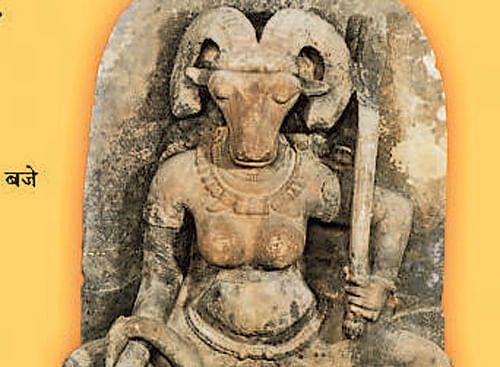
An 1,100-year-old priceless sculpture has returned to India, years after it was stolen from an ancient temple in Uttar Pradesh and was smuggled to France.
The exquisite 10th-century stone sculpture of “Vrishanana Yogini” was stolen from an unprotected ancient temple at the Lokhari village in the Banda district of UP, and found its way to France. It has now come back to be a prized possession of the National Museum in Delhi, thanks to the family of late French art collector Robert Schrimpf, who had acquired it after it reached France.
Schrimpf’s widow Martine donated the sculpture of the goddess with a buffalo-shaped head to the Embassy of India in Paris in 2008. The Ministry of External Affairs and Ministry of Culture worked together to finally get it back to India last month.
Though many stolen sculptures and other cultural properties, often smuggled out of the country, were subsequently traced in the US, Australia and Europe, most of them could not be repatriated, primarily due to legal obstacles. What has made the return of the Vrishanana Yogini significant is that the sculpture could be brought back without much hassle after it was donated by Schrimpf's widow.
“Three things went in our favour: We established its authenticity on the basis of the book Yogini: Cult and Temples – A Tantric Tradition brought out by the museum in 1986, which carried its picture; the widow of the French art collector couldn’t confirm the source of its acquisition; and the art collector’s donation letter was executed through an attorney,” said J E Dawson, Curator (Archaeology) of the National Museum, who had to go to Paris to make a foolproof case for the return of the sculpture, weighing 400 kg.
The National Museum is celebrating this “homecoming” with a special exhibition, to be jointly inaugurated by External Affairs Minister Salman Khurshid and Culture Minister Chandresh Kumar Katoch, on September 19.
“The return of Vrishanana Yogini is a triumph of the country’s sustained efforts to get back its stolen antiquities,” said National Museum Institute Dean Anupa Pande.
“A major objective of the exhibition is to increase awareness about the fascinating history of the Yoginis and the elaborate rituals of their worship.
More importantly, it aims to bring into spotlight the disturbing reality of the continued illicit trafficking of India’s priceless cultural artefacts to international markets,” said National Museum director general Venu V.
The Yogini cult developed between sixth and 10th centuries, rooted in sacred texts like Skanda Purana, Agni Purana, Kaulajnananirnaya and in lists called Yogininamavalis.
The Yoginis — a group of powerful female divinities, a blend of the divine and demonic — were worshipped in totality of 64 or 81, seldom individually.
Yogini temples are located in isolated areas and have been easy targets of antique smugglers. Yogini sculptures from Kanchipuram are now found in leading museums across the world.
“The return of the Vrishanana Yogini, in this context, is significant,” said Venu.
